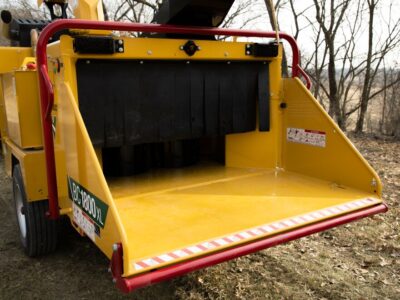Vermeer knows what matters most in landscape and tree care safety
Staying safe on the jobsite has never been more critical. Tree care and landscape professionals face daily challenges and tough, unpredictable working conditions. Historically, these hazards were simply part of the job, with little in the way of standardized safety gear, formal training, or machine safeguards.
Over the past few decades, incredible progress has been made in raising tree care safety awareness and giving crews the critical training, gear, and equipment to work more confidently and productively. From the personal protective equipment (PPE) worn onsite to the engineering innovations built into modern machines, a heightened emphasis on worker protection has reshaped what it means to be a professional.
Lessons from the past: How tragedy sparked change
The early days of professional tree care were marked by hard-earned lessons and tragedies, including job-site injuries and fatalities, that prompted serious momentum for formal tree care safety standards. This event and others led to the creation of the ANSI Z133 Safety Standard for Arboricultural Operations, still the industry’s primary safety guide today. Meanwhile, the U.S. Occupational Safety and Health Administration (OSHA) was established in 1970, creating a legal framework for workplace safety.
Innovation at work: Safety-driven equipment design
And Vermeer is more than committed to that effort. Designing safety into equipment is among the most powerful ways to protect workers. Here safety isn’t just an add-on — it’s a part of the DNA of every machine. Vermeer product engineers and specialists constantly seek ways to help crews stay productive and safe.
“Continuous improvement, both in protecting operators and making them more productive, drives our innovation at Vermeer,” says Josh Vrieze, Environmental Group Product Manager “We listen to feedback from our customers and operators, and continue to build smart solutions that help crews navigate all aspects of a jobsite, including safety and productivity.”
Some of Vermeer’s safety innovations include the bottom feed stop bar on brush chippers and operator presence system on stump cutters, mini skid steers and compact articulated loaders (ATXs).
Brush chippers: Raising the bar with bottom feed stop bars
Understanding the real-world dangers operators face near feed rollers, Vermeer pioneered the bottom feed stop bar on brush chippers, offering the patented feature into the North American industry in 2010 (U.S. Patent Number 7,044,409) . The bottom feed stop bar can be triggered instinctively with a leg or body — buying crucial seconds.
This patented feature comes standard on all Vermeer brush chippers and at the time of its introduction, was free to license by other manufacturers. The ‘409 patent has since expired in 2023. “In the same way Volvo invented the three-point seatbelt and made it available to other automakers, we see the bottom feed stop bar as a critical feature that should be on every brush chipper, no matter who manufactures it, particularly now that the ‘409 patent has expired” said Vrieze.
Other key features in brush chippers include:
- Extended infeed tables and safety curtains: Modern chippers feature longer, funnel-shaped infeed tables and rubber or fabric curtains to contain debris and keep operators further from the drum.
Stump cutters: Smarter systems with operator presence technology
Nearly five decades after inventing the stump cutter in 1957, Vermeer began partnering with the National Institute for Occupational Safety and Health (NIOSH) in 2001 to develop a passive operator presence system (OPS) that did not require the operator to engage a separate handle or switch.
Introduced on SC30TX stump cutters in 2008, OPS uses capacitive sensors in the control handles, so the system automatically stops the cutter wheel if the operator’s hands leave the controls Other key features on Vermeer stump cutters include:
- Guarding and containment: Modern stump grinders have guards and curtains to help contain flying debris.
- Remote control: Allows operators to work productively in unique jobsite conditions.
- Mechanical considerations: Electronic cut-off systems, improved wheel and tooth design, and better braking systems contribute to machine productivity and safety.
Beyond the basics: Building confidence into every machine
The commitment to tree care safety innovation doesn’t stop at hardware. Features like SmartFeed engine load management, intuitive emergency stops and better visibility are all part of a bigger picture: helping crews operate confidently.
“At Vermeer, we don’t just protect the operator, we empower them,” said Vrieze. “Safety and productivity can, and must, go hand in hand. The more protected operators feel on the job, the more focus they can direct to the task at hand.”
Sharing safety innovations with the world
Across the globe, tree care safety practices have come a long way. Organizations like the International Society of Arboriculture (ISA) and Tree Care Industry Association (TCIA) have championed better education, PPE adoption, and certification programs. ANSI Z133 continues to evolve, refining guidelines to address emerging risks.
Vermeer believes that raising safety standards across the industry benefits everyone: crews, contractors, communities and customers alike, which is why Vermeer partners with ISA and TCIA in a number of their advocacy initiatives.
This mindset has positioned Vermeer as a trusted leader not only in equipment design but also in shaping the future of safe work practices worldwide.
Vermeer Corporation reserves the right to make changes in engineering, design and specifications; add improvements; or discontinue manufacturing at any time without notice or obligation. Equipment shown is for illustrative purposes only and may display optional accessories or components specific to their global region.
Please contact your local Vermeer dealer for more information on machine specifications. Vermeer and the Vermeer logo are trademarks of Vermeer Manufacturing Company in the U.S. and/or other countries.
© 2025 Vermeer Corporation. All Rights Reserved.
